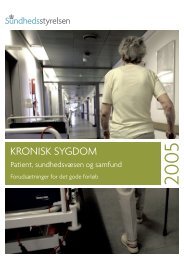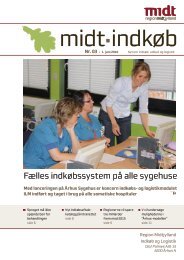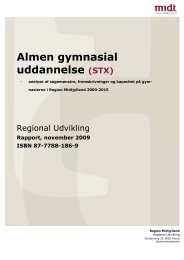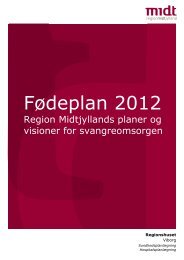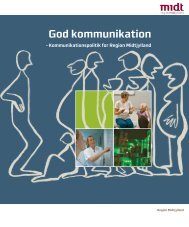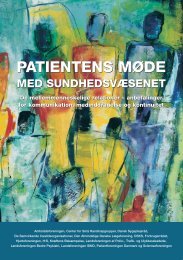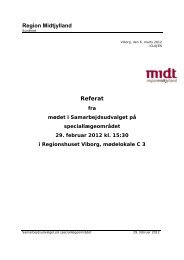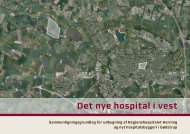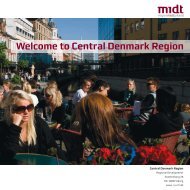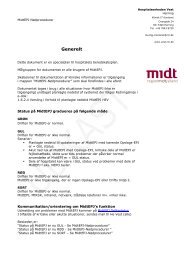OECD commends Central Denmark Region - Region Midtjylland
OECD commends Central Denmark Region - Region Midtjylland
OECD commends Central Denmark Region - Region Midtjylland
Create successful ePaper yourself
Turn your PDF publications into a flip-book with our unique Google optimized e-Paper software.
THEME The <strong>Region</strong> through outsiders’ eyes#15<strong>Central</strong> <strong>Denmark</strong> <strong>Region</strong><strong>Region</strong>al Development magazineEnglish version<strong>OECD</strong> <strong>commends</strong><strong>Central</strong> <strong>Denmark</strong> <strong>Region</strong>/ 4Silkeborg spreads its wings / 10<strong>Denmark</strong> on her CV / 14From paper boy to entrepreneur / 18
81012Jutland callingContentsTogether with its neighbours in thenorth and south, <strong>Central</strong> <strong>Denmark</strong><strong>Region</strong> has managed to put western<strong>Denmark</strong> on the world map and attractmore foreign investment.Silkeborg spreads its wingsOne of China’s biggest wind turbinemanufacturers, Envision Energy, hasestablished a global innovation centrein Silkeborg.Relaxed creativity<strong>Central</strong> <strong>Denmark</strong> <strong>Region</strong> is in a networkwith the world’s most creativeregions. The Belgian head of thenetwork is impressed and inspiredby his first visit here.1416THEME<strong>Denmark</strong> on her CV21-year-old Slovakian Monika is doingwell at VIA Campus Horsens, where sheis studying marketing management.When she has seen the world, she willsettle permanently in <strong>Denmark</strong>.My favourite universityRick L. Edgeman has left a managementjob at the University of Idaho tobecome professor of sustainability atAarhus University. He likes the fact thatthe students question his teaching andhave learned to think for themselves.Karen Maguire, <strong>OECD</strong>: “It’s impressive howfast the region has established itself as arecognised player and paved the way fordialogue and cooperation between relevantplayers in its hinterland.”Photo: Niels Åge SkovboThe <strong>Region</strong> through outsiders’ eyesPublished by: <strong>Region</strong>al Development,<strong>Central</strong> <strong>Denmark</strong> <strong>Region</strong>Editor-in-chief: Lars VildbradEditor: Marianne Harbomarianne.harbo@ru.rm.dkGraphic production: Grafisk ServicePhotos: Niels Åge Skovbo#15We connect people<strong>Central</strong> <strong>Denmark</strong> <strong>Region</strong> covers the central partof Jutland from coast to coast. With approx.1.3 million inhabitants, it is <strong>Denmark</strong>’s secondlargest region after the Capital <strong>Region</strong>.The landscape in <strong>Central</strong> <strong>Denmark</strong> <strong>Region</strong> isvery varied, from the North Sea and its dunes inthe west through beautiful lake highlands in thecentre to attractive bays and idyllic inlets on theeastern side of the region.Attractive region for companies<strong>Central</strong> <strong>Denmark</strong> <strong>Region</strong> has great growthand development potential and is opento international cooperation. The regionrepresents a vibrant economic life, strongcompetencies in relation to knowledgeenvironments, research and education, andrapid population growth. In the eastern part ofthe region, the growth zone Aarhus attractsmanpower and investments, partly becauseof the many institutions of higher educationincluding Aarhus University which is rankedamong the world’s top 100 universities. Aarhusalso has <strong>Denmark</strong>’s largest container port foroverseas container transport. The western partof <strong>Central</strong> <strong>Denmark</strong> <strong>Region</strong> is the cradle forseveral major companies, such as Bestseller(clothing), Bang & Olufsen (high-end televisions,music systems etc.), Vestas Wind Systems(wind turbines) and Siemens Wind Power (windturbines).Positions of strength<strong>Central</strong> <strong>Denmark</strong> <strong>Region</strong> is actively working todevelop existing and new positions of strength.ICT constitutes a position of strength which isconstantly developing, and in particular the ICTresearch at the Alexandra Institute in Aarhus’ ITcity has attracted many companies.Within foodstuffs, the Danish Institute ofAgricultural Sciences’ Research Centre Foulumis the centre of livestock and plant research in<strong>Denmark</strong> and collaborates closely with manycompanies.Within health, an extension of Aarhus UniversityHospital to become the largest hospital inScandinavia with associated health technologyindustries and the construction of a newhospital in Gødstrup in the western part of<strong>Central</strong> <strong>Denmark</strong> <strong>Region</strong>, will become importantdriving forces behind the development of thehealth system in the region and in <strong>Denmark</strong> asa whole.Within energy, <strong>Central</strong> <strong>Denmark</strong> <strong>Region</strong> enjoysa particularly strong position, with some of theworld’s largest wind turbine manufacturers.Interested in connecting with <strong>Central</strong> <strong>Denmark</strong><strong>Region</strong>?Try us:Niels Erik K. Andersen, head of InternationalOffice, phone: +45 7841 1120niels-erik.andersen@ru.rm.dk
Foreword”It’s not a bad thing to take a look at our region through the eyes ofothers. We have much to offer in terms of skilled employees andinternationally recognised knowledge environments. ”Welcome to our region!Aglobally competitive international growth region. That is the vision for <strong>Central</strong> <strong>Denmark</strong><strong>Region</strong>. Our work with internationalisation not only involves cooperation withinternational partners and strengthening the position of companies in <strong>Central</strong> <strong>Denmark</strong>in global markets, but also attracting foreign students, employees and businessesto the region.Studies show, for example, that foreign employees play an important role in the export opportunitiesfor companies, and that, even if foreign students return home after graduation, theyare good ambassadors for <strong>Denmark</strong> and <strong>Central</strong> <strong>Denmark</strong> <strong>Region</strong> around the world.So it is important that our region is known around the world as the place to move to, whetherwe are talking about investors, entrepreneurs, researchers, students or employees.And how do they perceive <strong>Central</strong> <strong>Denmark</strong> <strong>Region</strong>? That is what this issue of Dialogue isabout.Meet a number of foreigners who, for one reason or another, have chosen <strong>Central</strong> <strong>Denmark</strong><strong>Region</strong>, and who have experienced life here.You can also read about how the investment promotion association Foreningen VestdanskInvesteringsfremme helps to ensure that foreign companies are made aware of our part of thecountry and choose to become established here. Over the past three years, this has meant thatmore than 1,200 jobs have been created or maintained in western <strong>Denmark</strong>.And you can meet a representative of the <strong>OECD</strong> who has recently analysed our growth environmentand opportunities, and given us “thumbs up”. However, the <strong>OECD</strong> also has a numberof recommendations on how we in the region can become even better at working internationally,and become even more attractive on the global market.It’s not a bad thing to take a look at our region through the eyes of others. We have much to offerin terms of skilled employees and internationally recognised knowledge environments.Welcome to our region!BENT HANSENDIALOGUE theme: The <strong>Region</strong> through outsiders’ eyes 3
TEXT: LOTTE WINKLER PHOTOS: NIELS ÅGE SKOVBOThe <strong>OECD</strong><strong>commends</strong><strong>Central</strong> <strong>Denmark</strong> <strong>Region</strong><strong>Central</strong> <strong>Denmark</strong> <strong>Region</strong>’sGrowth Forum is a vehicle ofgrowth that other regionsin the world can learn from,according to the <strong>OECD</strong>, whichawards the region’s workgood marks in a major study.<strong>Central</strong> <strong>Denmark</strong> <strong>Region</strong> looksgood seen from Paris. KarenMaguire, Policy Advisor at the<strong>OECD</strong>, <strong>commends</strong> the region forits efforts to create growth andre<strong>commends</strong> that the region nowturns its gaze abroad in order toattract new knowledge directly toits proritised sectors.4 DIALOGUE theme: The <strong>Region</strong> through outsiders’ eyes
Since its inception in connection with the municipalreform in 2007, <strong>Central</strong> <strong>Denmark</strong> <strong>Region</strong> has focusedon promoting growth and development in its19 municipalities. But there is still some way to gobefore the region is among the best in the world.This is the <strong>OECD</strong>’s assessment of the <strong>Central</strong> <strong>Denmark</strong><strong>Region</strong>.As Policy Advisor in the <strong>OECD</strong>’s <strong>Region</strong>al DevelopmentPolicy Division, Karen Maguire has overseen the preparationof a report on <strong>Central</strong> <strong>Denmark</strong> <strong>Region</strong> and the <strong>Region</strong>of Southern <strong>Denmark</strong>, which together account for 42% <strong>Denmark</strong>’seconomic growth from 1998–2008. This is more thanthe Capital <strong>Region</strong>, which has generated 37%.The report is a review, a thorough investigation, which<strong>Central</strong> <strong>Denmark</strong> <strong>Region</strong> and the <strong>Region</strong> of Southern <strong>Denmark</strong>jointly commissioned the <strong>OECD</strong> to conduct in 2011,in order to learn more about how the two regions’ growthforums can enhance growth and innovation in the future.Vehicle of growth“<strong>Denmark</strong> is a country with great potential to increaseits productivity, and yet the rise is slow. In this respect, it isdifficult to advise the regions, as there are no immediatelyobvious solutions,” Karen Maguire tells Dialogue.Generally speaking, the <strong>OECD</strong> has plenty of praise for theregion’s Growth Forum and the effective public-private partnershipgoing on there. A “terrific vehicle of growth” is howKaren Maguire describes the assembly of representatives ofthe business community, knowledge and educational institutions,the labour market and local and regional politicians.factsmThe <strong>OECD</strong>’s analysis report can beobtained from:regional-udvikling@ru.rm.dkWhat the <strong>OECD</strong> re<strong>commends</strong>Despite the good marks awarded to <strong>Central</strong> <strong>Denmark</strong> <strong>Region</strong>and the <strong>Region</strong> of Southern <strong>Denmark</strong>, the <strong>OECD</strong> neverthelesslists a number of specific recommendations in the report(see also the following pages).In addition to the need for continued focus on developingand attracting the needed skills to the region, the <strong>OECD</strong>stresses that the time has come for <strong>Central</strong> <strong>Denmark</strong> <strong>Region</strong>to become a bigger player on the international scene, andincreasingly work to attract international knowledge to itsprioritised sectors, allowing them to develop and grow evenstronger.“The thorough mapping of the region’s own competencesand strengths carried out in recent years has been an importantand necessary phase for <strong>Central</strong> <strong>Denmark</strong> <strong>Region</strong>. Butnow, the region must take the next step and apply its accumulatedknowledge to branding itself internationally,” statesKaren Maguire.Setting a good exampleFollowing close dialogue with the municipalities in the region,Growth Forum <strong>Central</strong> <strong>Denmark</strong> has identified fourstrengths of <strong>Central</strong> <strong>Denmark</strong> as points of orientation for regionalinvestment. These include energy technology, foods,welfare innovation and tourism.According to the <strong>OECD</strong>, the prioritisation of positions ofstrength is important, and the cooperation and dialoguethat takes place in the Growth Forum involving several parties– both public and private – is a model the whole worldcan learn from.“The learning curve in <strong>Central</strong> <strong>Denmark</strong> <strong>Region</strong> has beensteep. It’s impressive how quickly the region has establisheditself as a recognised player and paved the way for dialogueand cooperation between relevant players in the hinterland,”says Karen Maguire.An important roleShe and her <strong>OECD</strong> colleagues agree that the regions play acrucial role for growth and innovation in the entire country.The regions’ in-depth local knowledge allows them to piecetogether a picture of the resources, skills and potential indifferent parts of the country and communicate it directly tothe state, thereby influencing the national growth strategy.“This is a task the 98 municipalities could not performthemselves. They would not have the same overview, andwould find it difficult to attract the attention of decisionmakersin the capital. It is easier for five regions to be heardin this context,” explains Karen Maguire.More international linkagesThe <strong>OECD</strong> therefore re<strong>commends</strong> that <strong>Central</strong> <strong>Denmark</strong><strong>Region</strong> establishes more linkages and contacts nationallyand internationally and strengthens the building of a criticalmass of competences in companies and knowledge institutionswithin its prioritised sectors.According to the <strong>OECD</strong>, it would e.g. have a positive effecton the region’s productivity to attract even more foreign researchersto <strong>Central</strong> <strong>Denmark</strong>’s knowledge institutions. And,conversely, to send more researchers from <strong>Central</strong> <strong>Denmark</strong>out into the world, so they can return with new knowledgeand a valuable international networks, which also canbenefit businesses.Business people and students can also be direct channelsfor increased dialogue and networks abroad.Internationalisation is not a task for <strong>Central</strong> <strong>Denmark</strong><strong>Region</strong> alone. Many stakeholders, such as businesses, municipalities,educational institutions, trade associations andgovernment departments – including Invest in <strong>Denmark</strong> –can pull in the same direction.“But the region plays an important role in gatheringstakeholders, and facilitating the sharing of new internationalknowledge for innovation and growth,” explains KarenMaguire, who also finds that <strong>Central</strong> <strong>Denmark</strong> <strong>Region</strong> is wellequipped for growth with <strong>Denmark</strong>’s second largest city, arecognised university environment and strong, global companies.DIALOGUE theme: The <strong>Region</strong> through outsiders’ eyes 5
factsmDuring the study, an <strong>OECD</strong> delegation visited <strong>Central</strong> <strong>Denmark</strong><strong>Region</strong> and the <strong>Region</strong> of Southern <strong>Denmark</strong> on twooccasions. The <strong>OECD</strong> held meetings with members of theGrowth Forum and regional councils, representatives oflarge and small businesses, business development actors,research and educational institutions, as well as national,regional and municipal officials. Experts in regional businessdevelopment policy from the UK and Norway have also contributed.The study is part of a series of regional reviews conducted bythe <strong>OECD</strong>. The series includes – among others – reviews ofPiedmont in Italy, the Basque Country and Catalonia in Spain,Wallonia in Belgium and the north of England.6 DIALOGUE theme: The <strong>Region</strong> through outsiders’ eyes
factsmThe <strong>OECD</strong>’s recommendationsIn its analysis, the <strong>OECD</strong> points to the need forinnova¬tion and business development initiatives basedon specific local and regional conditions. Specific recommendationsare also presented pertaining to futurework to support innovation and business development.The recommendations can be grouped under four mainheadings:Global relevance■This includes promoting regional actorsparticipation in international networks; andfocusing more on the prioritised sectors’ challengesand opportunities in a global – and notjust regional and national – perspective.Addressing skills■This includes an effort to attract and develophigh-skilled workers and, not least, an effortto raise the skill-levels of the low-skilled.Clarity on growth targets■Greater clarity on which growth targets arerealistic, as well as ob whether the target ismaximising overall growth or growth everywherein the region.The partnership model as a means of achieving regionaltargets■Includes municipal-regional, inter-regionaland regional-national partnerships. The <strong>OECD</strong>re<strong>commends</strong> considering more long-termcommitments between region and state toaddress bottleness to growth, possibly withassociated funding.DIALOGUE theme: The <strong>Region</strong> through outsiders’ eyes 7
utlandallingTEXT: LOTTE WINKLER PHOTOS: NIELS ÅGE SKOVBOTogether with itsneighboursin the north and south,<strong>Central</strong> <strong>Denmark</strong> <strong>Region</strong>has managed to putwestern <strong>Denmark</strong> onthe world map and attractmore foreigninvestment. The headof the Trade Councildescribes the results asremarkably impressive.factsmThe three growth forumsin <strong>Central</strong> <strong>Denmark</strong><strong>Region</strong>, North <strong>Denmark</strong><strong>Region</strong> and the <strong>Region</strong> ofSouthern <strong>Denmark</strong> haveextended the fundingof FVI, so, until the endof 2014, the associationwill continue its effortsto put western Danishcompetencies on theworld map through cooperationbetween theregional project managersand Invest in <strong>Denmark</strong>’semployees in Copenhagenand around the world. Thefunding pays for eightregional project managerslocated in Aalborg, Herning,Aarhus, Kolding andOdense.Foreningen Vestdansk Investeringsfremme(FVI) is a success. It has broken the almostmagnetic attraction of Copenhagen, attractingforeign investors to parts of thecountry west of the Great Belt. Just six years ago,western <strong>Denmark</strong> received only two out of ten foreigninvestors. Today, this has evened out.At the same time, the number of foreign investorswho establish branches or take over businesses in<strong>Denmark</strong> has grown. So FVI’s targeted work to makeforeign companies aware of Jutland’s knowledgeenvironments and competencies has not been at theexpense of the capital.This brings a smile to the face of the people atthe Trade Council, where <strong>Denmark</strong>’s endeavoursto attract foreign investment and businesses aregathered in the organisation Invest in <strong>Denmark</strong>. Thepartnership with FVI is close and successful.“We are very pleased with what the associationhas done, as it has really produced results. Withoutit, most foreign investment would have continued togo to the capital area, as this kind of thing does nothappen of its own accord,” says Vibeke Rovsing Lauritzen,Head of the Trade Council.Value for moneyBehind FVI are <strong>Central</strong> <strong>Denmark</strong> <strong>Region</strong>, North <strong>Denmark</strong><strong>Region</strong> and the <strong>Region</strong> of Southern <strong>Denmark</strong>.Recognising that combined forces are more effectivethan a piecemeal approach, the regions have jointlyemployed eight project managers, located in thewestern Danish knowledge environments such asthe Alexandra Institute in Aarhus. The project managerswork with Invest in <strong>Denmark</strong>’s employees inthe US, Asia and Europe.“The project managers in the three regions linktheir knowledge of the professional network in thehinterland with our employees’ contacts around theworld, making Invest in <strong>Denmark</strong> very convincingin its argument about where investors get the mostvalue for money,” says Vibeke Rovsing Lauritzen.Over three years (2009-2011), FVI has created orretained 1,257 jobs in western <strong>Denmark</strong> in cooperationwith Invest in <strong>Denmark</strong>. That is 257 more thanwas expected. And by autumn 2012, a further 487jobs have been the direct result of the partnership.“The good results should be seen in the light ofthe fact that international competition for investmentis extremely tough. In Europe alone, thereare over 100 investment promotion agencies – bothstate and regional – with whom we are in daily competition,”explains Lauritzen, stressing that the resultsare therefore remarkably impressive.Ripple effectsIt takes a long time to get an investor to decide tosettle in <strong>Denmark</strong>. Sixteen months on average.Right from the very first contact, Invest in <strong>Denmark</strong>provides free information and analyses, contactwith potential partners, contact with the relevantpublic authorities and research institutions and prepackagedexcursions in <strong>Denmark</strong>. During the actualestablishment, Invest in <strong>Denmark</strong> also offers practicalassistance.“Every time we get an investor to <strong>Denmark</strong>, thepositive effects spread like ripples. If an investoracquires a business threatened with closure in westernJutland, for example, we not only keep the jobs»»news in briefMore tourists and jobs to remote areas<strong>Central</strong> <strong>Denmark</strong> <strong>Region</strong> is the principal organiser of a DKK53 million project to strengthen coastal tourism and createemployment in remote areas of the country. The newlyestablished Knowledge Center for Coastal Tourism in HvideSande is the project manager and coordinator. The projectincludes a general initiative to boost the quality of tourismand five regional demonstration projects to promote positive8 DIALOGUE theme: The <strong>Region</strong> through outsiders’ eyesexperiences. It is a national project, which, for the first time,has been able to bring together <strong>Region</strong> Zealand, the <strong>Region</strong> ofSouthern <strong>Denmark</strong>, North <strong>Denmark</strong> <strong>Region</strong>, <strong>Central</strong> <strong>Denmark</strong><strong>Region</strong> and Ringkøbing-Skjern Municipality and players andorganisations within the tourism industry in a joint effort tostrengthen coastal tourism.Information: hanne.johansen@ru.rm.dk
factsmWestern <strong>Denmark</strong> is branded internationally,especially in the areas of information and communicationtechnology (ICT), life sciences (biotech/biomedicine)and cleantech (renewableenergy/environmental technology). As a newinitiative, FVI also focuses on design.All in all, FVI has helped to create or retain2,256 jobs in western <strong>Denmark</strong> since 2007. Ofthese, 481 are in <strong>Central</strong> <strong>Denmark</strong>.Foreign investment does not happen ofits own accord. It takes a professionaleffort to convince major foreigncompanies that it can be to their advantageto settle in western <strong>Denmark</strong>. Headof the Trade Council, Vibeke Rovsing Lauritzentherefore praises Foreningen VestdanskInvesteringsfremme's cooperationwith Invest in <strong>Denmark</strong>.Photo: Robert Steadman.Read more at www.investindk.comhere, but also maintain the livelihood of the company’s suppliersand business partners,” explains Lauritzen.Chinese expectationsIn this context, she praises the local work of FVI toequip municipalities to present themselves convincinglyto foreign delegations. Everything has to be justright, down to the smallest detail when, for example, thesenior management of a large Chinese group visits.“They expect the mayor to put in an appearance. Bigcities like Aarhus know that, but it’s not certain that all thesmaller municipalities have experience of what it takes to landan investment. This is where FVI really comes in,” Lauritzennotes.As an example, she mentions a manual written by FVI toprovide municipalities with useful advice on investment promotion.The manual includes a checklist for municipalities receivingvisits from foreign investors.International schools“There has been a professionalisation in the municipalities ofthe three regions with regard to preparing the ground for internationalinvestment. I have the impression that the politiciansand civil servants are extremely committed to doing things inthe best way possible, and this is a positive development,” shesays.Much has improved, but Vibeke Rovsing Lauritzen would, forexample, still like to see more international schools in western<strong>Denmark</strong>.“Extra facilities play a major role when foreign knowledgecompanies are looking for a suitable location. They need a highlyqualified workforce – often international staff – and so thepossibility of international schooling is important,” she says.Money for new artIn August 2012, the <strong>Region</strong>al Council of <strong>Central</strong> <strong>Denmark</strong> <strong>Region</strong>granted DKK 250,000 for the development of Art Writing – anew art form which combines literature with visual art, sound,performance and digital media. The development projectconsists of a number of sub-projects, such as an internationalconference, mapping, presentation and dissemination of the artform as well as student-run workshops at partner institutions,including Forfatterskolen (writers’ school), the Jutland ArtAcademy and Aarhus University. The project will lead to theestablishment of a Knowledge Centre for Art Writing based atAarhus Centre for Literature at Godsbanen in Aarhus.Information: tine.mogensen@ru.rm.dkDIALOGUE theme: The <strong>Region</strong> through outsiders’ eyes 9
TEXT: MARIANNE GREGERSEN PHOTO: NIELS ÅGE SKOVBOSilkeborgspreads its wingsInvest in <strong>Denmark</strong> has beensuccessful in getting oneof China’s largest windturbine manufacturers,Envision Energy, to establisha global innovation centrein the region.Two years ago, twoengineers started inSilkeborg. Today they are 30.Pictured here is Anders Rebsdorf with the wind turbinedeveloped by the Global Innovation Centre of Chinese companyEnvision Energy in Silkeborg. The blades are split in two andthe outer part can rotate. This saves on transportation andinstallation costs, and makes the turbine less sensitive totyphoons in China. According to Rebsdorf, constructing a turbinewhich is different technologically makes the development workfun.»»news in briefHow the <strong>Region</strong> surveys your site<strong>Central</strong> <strong>Denmark</strong> <strong>Region</strong>, in collaboration with COMPLOT Media,has produced a series of short films which, among other things,show what citizens can expect when the region comes out tosurvey their sites for soil contamination. Watch the films on theEnvironmental Department’s website: www.jordmidt.dkInformation: thomas.damgaard@ru.rm.dk10 DIALOGUE theme: The <strong>Region</strong> through outsiders’ eyesNice to know about youth education programmes<strong>Central</strong> <strong>Denmark</strong> <strong>Region</strong> has launched a regional newsletter onyouth education programmes. “Nice to know” is issued quarterlyand will include news on regional education programmes andbrief information on national initiatives, new legislation andanalyses of youth education programmes.Information: maria.pedersen@ru.rm.dk
A1.5-metre high model of a wind turbine at DirectorAnders Rebsdorf’s office in Silkeborg isat first glance the only indication that one ofChina’s largest wind turbine manufacturers,Envision Energy, is based here. The Chinese companymoved here because <strong>Denmark</strong> is the place to be whenit comes to wind turbine knowledge and innovation.This was the conclusion of the Chinese director andfounder of Envision Energy, Lei Zhang, when he lookedat several European countries with a view to findingthe location for his global innovation centre.Ably assisted by Invest in <strong>Denmark</strong>, Lei Zhang wasconvinced that Envision Energy would benefit from thehigh level of expertise in wind turbines here in <strong>Denmark</strong>.He handpicked Anders Rebsdorf, who had many years ofexperience from Vestas, Gamesa and DONG, as Director.Silkeborg was chosen as the location as it offers the opportunityto recruit from a wide area. And since the startwith just one employee, many engineers have joined.Now there are 30 employees, three of whom are Chinese,and the company is outgrowing its premises while developinga new wind turbine for the Chinese owner. Close tothe cradle of the Danish wind turbine adventure.First “baby” developedHanging in the canteen are pictures of the innovationcentre’s first “baby”. An offshore turbine, which is readyfor testing in Thyborøn in collaboration with DONG andRisø, while a larger turbine, which is to be tested at thenational test centre in Østerild, is under way. EnvisionEnergy’s ambition is to erect the first foreign turbineon Danish soil in collaboration with Danish or Europeanpartners.“We’re still kind of on trial, but we will of course continueto talk about the benefits of our technology,” saysAnders Rebsdorf.“Our Chinese sponsors have invested a lot of moneyin establishing the innovation centre, and so far thehighly paid employees have ensured healthy tax revenuesin <strong>Denmark</strong>. But the owner also expects to getsomething back to support our development activities.”Older brother in ChinaEnvision Energy also has a development departmentin China, which is about twice the size of the one inSilkeborg, and e-mails, conference calls and visits flowback and forth between the two branches. The olderbrother in China learns from the younger brother in<strong>Denmark</strong>.“The primary objective of our department is the developmentof technology and patents. In addition, we givethe department in China direction and teach them newmethods and processes. And help pave the way for closecooperation with suppliers,” says Rebsdorf.“As Danes, we also learn from the prevalence of dynamismand commitment in China.”In <strong>Denmark</strong>, Envision Energy works extremelyclosely with subcontractors, many of whom are from<strong>Central</strong> <strong>Denmark</strong>.“We would like to be the third largest producer ofwind turbines in <strong>Denmark</strong> after Vestas and Siemens,but we do it differently by giving subcontractors greaterresponsibility. We help optimise them so that theybecome sharper and benefit from the knowledge theygather,” explains Rebsdorf.“It would be great if other wind turbine manufacturersfrom outside settled here because of the extensiveaccumulated knowledge. This would provide asynergistic effect, as we would challenge one anotherand the subcontractors.”A bigger sceneThe fact that <strong>Denmark</strong> invests heavily in wind energy,including in the Government’s 2020 plan, means a lot toforeign investors, stresses Anders Rebsdorf, who sits onthe board of the Danish Wind Industry Association.“Fortunately, for many years we have had ambitiouspoliticians who know that there are jobs in wind energy.Foreign investment can help ensure that <strong>Denmark</strong>will be even more competitive in this field, and that wecan maintain a wind power hub,” he says.Anders Rebsdorf has nothing but praise for Investin <strong>Denmark</strong> and expects it to succeed in attracting furtherforeign investors to this part of the world.“They see opportunities in competition. They simplythink in terms of a bigger stage than many in <strong>Denmark</strong>.I could potentially see DONG, for example, thinkingbig like this. They might just learn something fromworking with a Chinese energy company,” Rebsdorfexplains.Hospitality is called forAccording to the director, there are challenges for aChinese wind company in <strong>Denmark</strong>.“In the space of two years, we have built up an innovationcentre and developed a new turbine, which weneed to test and demonstrate. The Chinese have footedthe bill, but it has been a challenge getting permissionto erect the turbine at the port in Thyborøn. We haveworked hard for this, and paid a lot for it. It would bemore hospitable if foreign firms were asked: What doyou need? How can we help you?” he points out. But heis glad that he said yes to heading the Envision GlobalInnovation Centre.“This is my opportunity to develop new, cutting-edgewind turbine technology, and the first two years havebeen very exciting. It’s a bit of an adventure,” he says.New book on education and vulnerable youthsA book entitled “Unge, uddannelser og sårbarheder” (Youth,education and vulnerabilities) is part of the “Mentallyvulnerable youths” study project, which the <strong>Region</strong>al Councilof <strong>Central</strong> <strong>Denmark</strong> <strong>Region</strong> helped finance with just underDKK 1.7 million from the education development pool. Theobjective of the project was to procure new knowledge aboutthe relationship between youths, education and vulnerability,with a view to more young people having the opportunity tocomplete a youth education programme.The project analyses vulnerability as both a psychological anda social phenomenon. It focuses on the relationship betweenindividual youths and youth education programmes and othersocial institutions.Read the book in full in Danish at www.rm.dk/via70670.htmlInformation: marianne.asstrupudsen@sosuranders.dkDIALOGUE theme: The <strong>Region</strong> through outsiders’ eyes 11
RelaxedTEXT: MARIANNE GREGERSEN PHOTO: NIELS ÅGE SKOVBO<strong>Central</strong> <strong>Denmark</strong> <strong>Region</strong> is amember of a network of the mostcreative regions in the world.The head of the network, BelgianPascal Cools, is impressed andinspired after his first visitin the region.factsmDistricts of Creativity is an exclusive global network and forumfor cooperation and the exchange of ideas on creativityand innovation for businesses, knowledge institutions andon a political level. <strong>Region</strong>al politicians Conny Jensen andUlla Diderichsen represent <strong>Central</strong> <strong>Denmark</strong> <strong>Region</strong>. Thenetwork consists of a total of 12 regions. The other regionsbesides <strong>Central</strong> <strong>Denmark</strong> <strong>Region</strong> are:Baden-Württemberg (Germany), Catalonia (Spain), Flanders(Belgium), Karnataka (India), Lombardy (Italy), Oklahoma(USA), Rhône-Alpes (France), Rio de Janeiro (Brazil), Scotland(UK), Shanghai (China) and Tampere (Finland).Head of the Districts of Creativity network, PascalCools mentions Aarhus as an example of the fact thatwhen creativity and entrepreneurship are promoted,this creates innovation. Along with 25 other membersof the international Districts of Creativity network,he has made his first visit to the city and is both impressedand inspired.When it comes to creativity, innovation and entrepreneurship,<strong>Central</strong> <strong>Denmark</strong> <strong>Region</strong> is streetsahead and has much to offer the global Districtsof Creativity network, where the 12 most creativeregions in the world meet and inspire one another, believesPascal Cools from Flanders. He is the head of the networkand director of Flanders Districts of Creativity. Flanders isthe initiator of the network, because Flanders’ days as a regionof heavy industry are numbered. And the big question ishow the region will make its living in the future. Flanders isnot alone in this, and therefore took the initiative to create aglobal cooperative forum.The network brings together creative minds from aroundthe world for workshops and holds an annual conference,Creativity World Forum, which focuses on creativity and innovationin response to societal challenges.The hope is that the Creativity World Forum will become acounterpart to the World Economic Forum.Becoming member of this fine network is not something thatany region around the world can do, just because they want to.They have to be recommended and then they are carefully assessed.Small city with much to offerIn 2010, <strong>Central</strong> <strong>Denmark</strong> <strong>Region</strong> was weighed in the balanceand not found wanting, and held the first event for 25 internationalmembers of the network in Aarhus, including PascalCools, who was both impressed and inspired.“We experienced innovation, creativity and technology ofa very high standard. And got the feeling that there’s a lot goingon here, from the big art museum Aros to Lynfabrikken in»»news in briefCompanies keen to accelerateDue to the high demand for business-oriented development,Growth Forum has now extended the VÆKSTmidt Acceleratorprogramme by two years, and additional funding of DKK 40million is being given.The programme will thus continue until 31 August 2014.Studies show that the programme covers a need among smalland medium-sized businesses, and the initiative will thereforecontinue with a few adjustments. Among other things, thecontent of the programme will reflect the companies' growthpotential to a greater extent.12 DIALOGUE theme: The <strong>Region</strong> through outsiders’ eyesInformation: lene.brinch@ru.rm.dk
creativitya backyard,” explains Cools, who was also thrilled tovisit Innovation Lab and KaosPilots.“I’m not the only one who was impressed and inspired.The representatives from Brazil, for instance,where the next Creativity World Forum is to be held,were very impressed that such a small city has somuch to offer,” he says.Not too much hierarchyAarhus is small, but thinks and acts like a large city.And that is perfect when you want to attract peopleand investments, according to Cools.“It’s a city where you feel welcome. A dynamic, vibrantand warm city. Normally, you associate Scandinaviawith coldness, but that’s not how it is in Aarhusat all. And it all takes place in a relaxed atmosphere,”he says.“The impression you get is of a city in harmony,where innovation abounds, bubbling with creativity,and where things are not taken too seriously, and thereis not too much hierarchy. This promotes innovation,as you don’t have to spend time and energy trying toimpress people higher up in the system, but can concentrateyour efforts on innovation.”The next time Pascal Cools visits <strong>Central</strong> <strong>Denmark</strong><strong>Region</strong>, he would like to see more than Aarhus. Andhopefully he will again be impressed and inspired.Creative industries dominateProject manager of <strong>Region</strong>al Development, MortenFalbe-Hansen, believes that being a member of Districtsof Creativity is beneficial for efforts to enhancecreativity and innovation in <strong>Central</strong> <strong>Denmark</strong> <strong>Region</strong>.He would like to see <strong>Central</strong> <strong>Denmark</strong> <strong>Region</strong> hostingthe Creativity World Forum in 2017, when Aarhus isEuropean Capital of Culture.“The creative industries are becoming more andmore dominant in the region, also in relation to thegrowth in number of jobs. The network means thatwe and our business partners have an easier time establishinginternational partnerships for businesses,educational institutions and organisations,” saysMorten Falbe-Hansen.Remaining a member of the fine Districts of Creativitynetwork requires an active effort. Otherwiseyou’ll be thrown out, which is what happened to tworegions last year.<strong>Central</strong> <strong>Denmark</strong> <strong>Region</strong>’s membership does notappear to be in danger because, according to the headof the network, Pascal Cools, other regions can learnfrom <strong>Central</strong> <strong>Denmark</strong> <strong>Region</strong>, which has managedto combine creative people with academics and boostentrepreneurship and innovation.“We must go back to the Renaissance, where therewas also entrepreneurship and business combinedwith design and creativity, science and technology.<strong>Central</strong> <strong>Denmark</strong> <strong>Region</strong> is already well on its way,” hesays.He points out that investment in creativity may bethreatened in times of crisis, but he believes it pays offin the long run.“It’s really important, as it’s the way we have to goif we are to compete with countries like Russia, Indiaand China,” he stresses.New opportunity for binding networksCompanies that are efficient at working closely with othercompanies in binding networks will grow faster and generatemore profit than those that are not doing this. This is whyGrowth Forum has decided to extend the cluster programme,KLYNGEmidt Netværksinitiativ, until 31 August 2014. Theprogramme is aimed at strengthening the growth potentialof SMEs through participation in commercial and bindingcooperation with three other companies, focusing on innovationand internationalisation.Information: mette.vilsboell@ru.rm.dkDIALOGUE theme: The <strong>Region</strong> through outsiders’ eyes 13
TEXT: LOTTE WINKLER PHOTO: NIELS ÅGE SKOVBO<strong>Denmark</strong> on her CVThe study environment is top notch at VIA CampusHorsens, where 21-year-old Monika from Slovakiahas made new friends from all over the world.Danes are a little difficult to get to know, butMonika does not give up that easily, which is whyshe has also made Danish friends in Horsens.21-year-old Slovakian Monika ishappy at VIA Campus Horsens, wherehalf of the students are foreignerslike herself. When she has seenmore of the world, she wants toreturn to <strong>Denmark</strong> to live and work.»»news in briefA plan for raw materialsThe <strong>Region</strong>al Council of <strong>Central</strong> <strong>Denmark</strong> <strong>Region</strong> has adopted“Råstofplan 2012 for <strong>Region</strong> <strong>Midtjylland</strong>” (raw materials plan2012 for <strong>Central</strong> <strong>Denmark</strong> <strong>Region</strong>). In short, the new rawmaterials plan sets out 152 quarry areas, of which 38 areas aresignificantly changed or new in relation to “Råstofplan 2008”.The primary raw materials in <strong>Central</strong> <strong>Denmark</strong> <strong>Region</strong> are14 DIALOGUE theme: The <strong>Region</strong> through outsiders’ eyessand, stone and gravel, but the plan also manages the futureextraction of clay, moler clay, ball clay, peat and lime.At www.raastofplan-midt.dk, you can read “Råstofplan 2012”and see maps of the areas designated as suitable for futurequarrying.Information: lars.kristiansen@ru.rm.dk
Chinese, Spaniards, Australians, Poles and Italians.Not to mention French, Russian, Indiansand Icelanders. The place is teeming withyoung people from all over the world at VIACampus Horsens, which offers technical and commercialcourses at university level, such as Global Business Engineeringand Value Chain Management. More than 40nationalities make their way through the large, modernbuilding every day, and out of 3,500 students, half arefrom abroad. One of them is Monika Predajnova. Sheis 21 years old, from Slovakia and studying MarketingManagement in her third semester. She is doing well atVIA in Horsens. “When I talk to my friends back homein Slovakia, studying the same as me, I’m glad that I’mstudying here. They learn so much theory that theywill never need to use, while the course here is muchmore practical,” Monika explains.Horsens rather than LondonShe has always known that she wanted an internationaleducation. So she applied to and was alsoaccepted for educational institutions in the Netherlands,the UK and <strong>Denmark</strong>. In <strong>Denmark</strong>, she actuallygot accepted at two places – at Aalborg Universityand VIA Campus Horsens. Of all the options, she choseHorsens.“I can study marketing here. I think it will be easierfor me to get a job with this degree than if I study historyor any of the other courses that I was acceptedinto at the other places. And besides, Horsens is closerto Germany, where my mother lives,” she explains. Thechoice wasn’t all that easy. Monika loves London andwould really like to live there at some point in her life.But she reasoned that getting a degree in <strong>Denmark</strong>was better for her.Free education“First, I stand out a little from all the rest when it stateson my CV that I have done my degree in <strong>Denmark</strong>. It’sa bit different. And secondly, I can take the course herefor free,” she explains. Finance is important for a youngforeign student. Monika’s mother covers her housingcosts in Horsens and gives her some spending money. Ifshe had studied in London, each semester would havecost money in addition to living costs.“Then I would have had to take out loans and getinto debt. By taking my BA in <strong>Denmark</strong>, I’ll be able toafford to take an MA in another country, where youhave to pay for it,” says Monika.More teaching, please!Generally, she likes the environment at VIA, which shedescribes as international and accommodating.The teaching is top notch, the tutors are friendlyand helpful, and they take their time to talk to the students.However, she would like to have more lessons.Some days she has only two seminars, and that’s notenough, she says.“My friends back home in Slovakia have a lot morelessons. Some of them have days when they are inschool from seven in the morning until seven at night.I don’t envy them, but I would like to be able to choosefrom several electives and learn more and improvemyself,” she says.Language barrierThe international environment makes it easy to bea foreigner at VIA, and Monika has a great sociallife. But it can be difficult to get to know the Danishstudents. According to Monika, the Danes always sittogether at lunch, and they don’t mix much with theforeigners. She believes that this comes down to thelanguage barrier.“I have friends from all over the world here, butvery few Danish friends. And the few Danish friends Ihave are friends because I pushed myself onto them.In fact, they have told me that I am their first foreignfriend,” she laughs.She would like to learn Danish and attends the languageschool in Horsens. After eighteen months, shefinds it fairly easy to read Danish, and the grammardoes not cause her major problems. But the pronunciationis another matter!So she mainly sticks to English. But Monika’s Englishhas suffered during her stay in <strong>Denmark</strong>. Themany different nationalities with different Englishskills and accents make it hard to remember howproper English should sound.“I really wish that we could be given English lessonsalongside the course. Students elsewhere inEurope are offered this, and I could really do with ithere,” she says.Next summer, and before Monika finishes herdegree in Horsens, she plans to take a gap year andtravel the world. She wants to find a job and have fun.Maybe in Malta.Wants to live in <strong>Denmark</strong>Monika is keen to experience more of the world andhas already tried travelling alone in India and othercountries. After graduating, she dreams of living inLondon, Prague or maybe somewhere in Italy.“But when I’m older – around 40, say – I want toreturn to <strong>Denmark</strong> and settle down permanently. I likeDanish society, where you certainly pay high taxes,but on the other hand you get free medical care andfree education,” she says.Moler clay cliffs in good companyWith the support of <strong>Central</strong> <strong>Denmark</strong> <strong>Region</strong>, <strong>Denmark</strong> hasapplied to have the two moler clay cliffs on Limfjord addedto the UNESCO World Heritage List, i.e. Hanklit on Mors andKnudklint on Fur. In connection with its application to UNESCO,<strong>Central</strong> <strong>Denmark</strong> <strong>Region</strong> is becoming part of a project groupthat contributes geological knowledge and involves the tourismand commercial aspect. The application was sent to UNESCO’ssecretariat in Paris in September 2012, where the materialwas assessed, and UNESCO’s proposals and wishes wereincorporated in the application material. In mid-December,it was returned to the Danish Agency for Culture. The DanishMinister for Culture may decide to submit the final applicationto UNESCO on behalf of the Danish Government. The applicationwill then be evaluated under the auspices of UNESCO until 1February 2014.Information: sven-henrik.brandstrup@ru.rm.dkDIALOGUE theme: The <strong>Region</strong> through outsiders’ eyes 15
My favourite universityTEXT: MARIANNE GREGERSEN PHOTO: NIELS ÅGE SKOVBOThe renowned American professorRick L. Edgeman has lectured andresearched at four American universities,but has now left his native USin favour of Aarhus University, wherehe is no longer content with frequentguest appearances.»»news in briefPessimists in the minorityOptimism in the business community of <strong>Central</strong> <strong>Denmark</strong> hasnow spread to all industries, according to a survey conductedby <strong>Central</strong> <strong>Denmark</strong> <strong>Region</strong> among small and medium-sizedenterprises. For the first time since the crisis, there are morepeople across the spectrum of industries who expect revenuegrowth rather than decline, when assessing the revenue of thefollowing three months compared to the same period last year.16 DIALOGUE theme: The <strong>Region</strong> through outsiders’ eyesOverall, 43% expect to see increased revenue, while 16%expect to see a decrease. In the retail trade, 63% expect risingrevenue, while 14% say it will remain the same, and 23%predict a decline. In industry, the figures are 54%, 35% and11%. However, overall, only one in five of the companies thinkthey will need to expand their workforce compared to the sameperiod last year, while 23% say they will probably be makingcuts.Information: soeren.tranberg@ru.rm.dk
The research environment isexcellent, and so are the students,according to Americanprofessor Rick L. Edgeman. Hisenthusiasm for Aarhus University is sogreat that he applied for and obtaineda position as professor of sustainabilityand performance in Business and SocialSciences.When Rick L. Edgeman came toAarhus in 1997 to work for a year as avisiting professor at the former businessschool, he lost his heart. Not to a woman,but to the university and the Aarhusarea.Since then, he has worked closelywith several professors on joint projectsacross the Atlantic and made guest appearancesat the university many times.Last summer, he taught at the summerschool for the third time. And in Januaryof 2012, he moved permanently to <strong>Denmark</strong>and started in his new job. His contractis provisionally for four years.It is a big decision to leave his homeland,but Rick L. Edgeman and his wifeJulie have sold their two houses andthree cars in the US and moved to Odderwith their 10-year-old daughter Emily.Excellent environment“I have really enjoyed coming here, eversince 1997. It’s my favourite university, asthe research community and the resultsare excellent, and the level of ambitionis high. I can teach the very talented studentsin English, and it is a lovely campushere. All criteria which mean a lot to me,”says Edgeman.He emphasises that a university isrecognised for its research and postgraduates,and Aarhus is doing reallywell.“Unlike in the US, the university holdson to its talents instead of sending themelsewhere to do research. This raisesthe academic standard. And AarhusUniversity has some very talented PhDstudents,” says Edgeman.He also seems to feel right at homein his little office at Fuglsangs Alle 20in Aarhus, where there are a numberof American honours on the wall, andshelves full of books in English.Since 1997, he has formed friendshipswith several people at Aarhus University,and his closest collaborator, ProfessorJacob Kjær Eskildsen, now sits a littlefurther down the corridor and not thousandsof miles away.Students can think forthemselvesRick L. Edgeman has a mathematicalbackground and was head of the Departmentof Statistical Science at theUniversity of Idaho, but he is passionateabout sustainability and innovation. Heis pleased that he now lives in a countrywhere this is high on the agenda, andthat he can do research on promotingand integrating sustainability into organisations’policies and practices, andhow sustainability can benefit the bottomline.“I enjoy having a life where everyday involves my passion and I can doresearch at a high level,” explains Edgeman.He also enjoys the fact that the relationshipbetween the professors andstudents is informal.“In the US, the students call me professoror doctor, and they treat me likea god. I’ve never liked that. In <strong>Denmark</strong>,they call me Rick. They question what Isay and that’s liberating.”He points out that Danish pupils areencouraged to think for themselves rightfrom primary school, and that this makesfor better college students.“At the same time, it makes the professor’sjob more challenging and stimulating,”smiles Edgeman.Safety firstIn addition to his exciting job at the university,he also appreciates the safety,peace and tranquillity of <strong>Denmark</strong>.The contrast to cities like Denver andWashington, where Rick L. Edgeman hasworked, is great. The safety aspect alsoattracted his wife Julie, who now enjoysbeing able to cycle with Emily to school,where she has made new friends.Julie Edgeman works as a consultantfor her American employer, and this arrangementworks well via e-mails andSkype despite the nine-hour time difference.She also attends Danish classes likeRick, so that they can pass the Danishtest and be allowed to stay in <strong>Denmark</strong>.The American professor has not onlysettled in well at the university, but alsoin Odder, where the family has set uphome. Rick also lived here in 1997 and,in his opinion, it is a great community,where his wife and Emily have also settledin well.Although Emily was initially reluctantto move, as Rick explains with a smile,she was also a big part of the reason tochoose <strong>Denmark</strong>.“In addition to the safety aspect, thequality of the school system is higherhere than in the US. I know that from theone year my three now grown-up childrenwent to school in <strong>Denmark</strong>. That iswhy we have decided that Emily shouldgo to a regular school instead of an internationalor private school,” he stresses.We get more in <strong>Denmark</strong>Many people have asked why he and hisfamily moved to the high taxes in <strong>Denmark</strong>,but the tax rate does not concernthe American professor.“When you add up all our costs for healthinsurance and tax, there’s not much difference.And the Danish system offersmuch more.”Food is very expensive for the Americanfamily, but it is of higher quality. Petrol isalso much more expensive, but this getsmore people cycling and using publictransport. The family, which had threecars in the US, was in <strong>Denmark</strong> for severalmonths before buying a car. Naturally,one that does a lot of kilometres to thelitre and thus protects the environment,as the sustainability aspect is importantto the professor.Risk capital to <strong>Central</strong> <strong>Denmark</strong>A new partnership between the Investment Fund for DevelopingCountries (IFU), <strong>Central</strong> <strong>Denmark</strong> and Business Link <strong>Central</strong><strong>Denmark</strong> aims to strengthen the globalisation of companiesin <strong>Central</strong> <strong>Denmark</strong>. IFU will place an investment consultantat Business Link <strong>Central</strong> <strong>Denmark</strong>, who will also market IFU’sconsulting service and offer of risk capital. The man in questionis Frank Zimmermann, a former branch manager at NordeaBank Thisted.Working with Danish companies, the independent stateinvestment fund IFU, has invested more than DKK 100 billionin 85 developing countries and emerging markets around theworld. About 20% of the investments have been made withcompanies in <strong>Central</strong> <strong>Denmark</strong> <strong>Region</strong>.Information: bent.mikkelsen@ru.rm.dkDIALOGUE theme: The <strong>Region</strong> through outsiders’ eyes 17
TEXT: LOTTE WINKLER PHOTO: NIELS ÅGE SKOVBOFrom paper boyto entrepreneurStudent Sarunas Vaisnoras favoursAarhus over Lithuania and is just about to start upcompanies number two and three via his networkwith other young people in Aarhus.Sarunas Vaisnoras is a busy man. The 25-yearoldLithuanian programs websites and websystems in his one-man business DataDogProgrammører in Aarhus, and the customersare pouring in.“It’s going really well,” he says modestly about thetwo-year-old business.His studies – an MA in Marketing at Aarhus University– have been put on the back burner because,at the same time as fitting in customers at DataDog,Sarunas is about to start up two new web-based companies.Both together with other young people, whom hehas met through his new office space in the StudentIncubator – an offer to student entrepreneurs.“A fellow student told me about the Student Incubator,and I was really surprised that such a place existswhere you can get free advice,” explains Sarunas.Help one anotherHe immediately took up the offer of an office space,but he has not participated in the courses for startups.“It would have been useful if I had known aboutthe place when I started DataDog, as I’m now so busythat I don’t really have the time to attend the courses,”he says. Almost apologetically.On the other hand, he benefits greatly from networkingwith the other entrepreneurs at the StudentIncubator. Often they can help one another to get customers.Or to develop new ideas.“For example, I help another student develop a websystem for his business, and in return he helps mewrite good Danish texts for my website,” he explains.MindTeacherSarunas also has office space in the entrepreneurialenvironment Startup City in Aarhus city centre. Heworks here with five other young people to developone of his two new web-based business ideas, Mind-Teacher.com – a professional provider of online videocourses, where interested parties can purchase instructionin everything from guitar playing to the artof giving a speech.“We have created the site, and the whole systemworks. Now all we need is the content. We need to findpartners who can produce good instructional films,and that is the challenge we face right now,” saysSarunas.In connection with this, the six young people havethemselves come up with mentors who have experiencefrom the web industry, and who can providegood, relevant sparring.“They are more than willing to help us, becausethey can see great potential in MindTeacher. This, ofcourse, gives us even more motivation and confidencein ourselves,” says Sarunas.Only two of Sarunas’ partners in MindTeacher areDanes. The others comes from Romania, Bulgaria andthe US.»»news in briefStay on the trainMore trains, new trains, shorter travel times, greater comfortand no changing.There were many benefits for passengers when interlinkedoperations began between the current Odder line and Grenaaline on 9 December 2012. This is the result of a joint venturebetween DSB and Midtjyske Jernbaner, which is owned by theregional transport services organisation Midttrafik.Though few people need to travel the entire stretch of justunder 90 kilometres, the interlinked operation will be arelief for the many thousands of passengers who have had tochange at Aarhus every day for their onward journey. In 2011,18 DIALOGUE theme: The <strong>Region</strong> through outsiders’ eyes
“Most of my friends here in Aarhus are foreigners.It’s easier for me to get together with other Englishspeakers. But since my Danish has improved, Ihave also got to know several Danish friends,” saysSarunas.From paper boy to self-employedSarunas Vaisnoras came to Aarhus when he was 18.He had heard good things about the student environmentin <strong>Denmark</strong> and wanted to study here.In the first few months, his parents helped himfinancially, but Sarunas wanted to pay his own way.So he delivered newspapers, cleaned, worked in awarehouse and in a shop.All while studying, first at the Business Schooland now at Aarhus University, where he is completingan MA in marketing.factsmThe Student Incubator in AarhusThe Student Incubator Aarhus is for all undergraduateand post-graduate students in Aarhus wishing to workwith entrepreneurship based on their academic qualifications.The students get free access to office spaceand the offer of coaching in the start-up and developmentof their own business. Around 50 companies arecurrently associated to the Student Incubator.During the course, he learned a little about programming,and the rest he taught himself by researchingonline.“I’ve always been good at maths and I think verylogically. It dawned on me that I could make moremoney by programming websites than from otherstudent jobs,” says Sarunas, who now makes a livingfrom DataDog.The first customers were typically small webshops, but now Sarunas has bigger customers, whereheavy databases have to be incorporated into userfriendlywebsites.A low hourly rate fills the order book up, and accordingto Sarunas, he has not needed to market DataDogsince its launch in 2010.Training in Lithuania“To start with, I sent jobs on to programmers in Lithuania,but now I program everything myself. The cooperationdidn’t really work,” he explains.The Lithuanian programmers are cheap, butthere was a problem with both communication andthe quality of the work. Sarunas is now consideringmoving to Vilnius for four to six months to trainLithuanian programmers so that they can meet hisexpectations.“Then I will return to <strong>Denmark</strong>. I like it here, andit’s important for me to be close to my customers. AndI also want to keep up my Danish.”the Odder line transported around one million passengers,while the Grenaa line had 1.2 million. At the same time, the40–45-year-old Y-train at Odder was taken out of service andreplaced by the more comfortable Desiro train.Information: per.holm@ru.rm.dkDIALOGUE theme: The <strong>Region</strong> through outsiders’ eyes 19
Magazine post UMMid no. 42717»»In brief<strong>Central</strong> <strong>Denmark</strong> <strong>Region</strong> facts and figures<strong>Central</strong> <strong>Denmark</strong> <strong>Region</strong> has 1.3 million inhabitants or 23 % of the totalpopulation of <strong>Denmark</strong>.<strong>Central</strong> <strong>Denmark</strong> is home to Aarhus, <strong>Denmark</strong>’s second city, with 252,000inhabitants (Aarhus city is part of Aarhus municipality, which has 315,000inhabitants in all).In 2009, the gross national product in <strong>Central</strong> <strong>Denmark</strong> <strong>Region</strong> was 38,000 europer inhabitant (national and EU averages were 40,600 and 23,500 euro perinhabitant respectively).In 2010 exports from businesses in <strong>Central</strong> <strong>Denmark</strong> <strong>Region</strong> totaled 23 billioneuro.The largest educational institutions in <strong>Central</strong> <strong>Denmark</strong> <strong>Region</strong> are AarhusUniversity with 34,000 students and VIA University College with 17,000 students.Students can study for an International Baccalaureate at four schools in the<strong>Central</strong> <strong>Denmark</strong> <strong>Region</strong>.<strong>Central</strong> <strong>Denmark</strong> <strong>Region</strong> has representation offices in Brussels, Shanghai, St.Petersburg and Budapest.THE NEXT ISSUEof Dialogue deals with how creativity and the creative industries can create innovation,growth, exports and jobs in <strong>Central</strong> <strong>Denmark</strong> <strong>Region</strong>.



